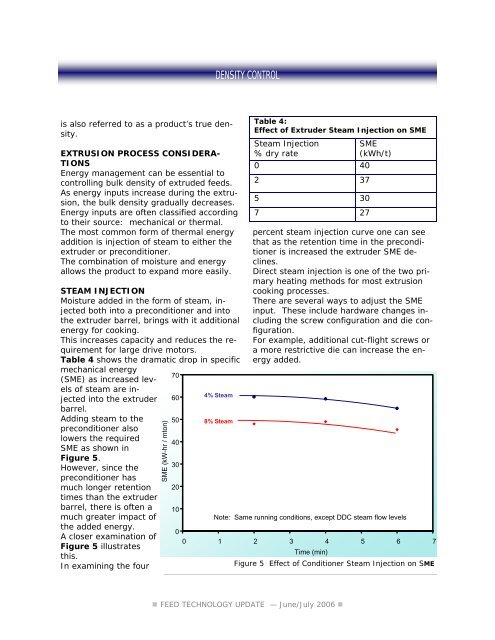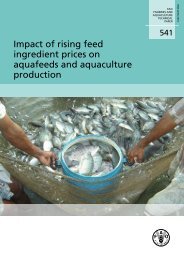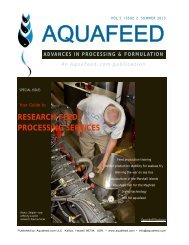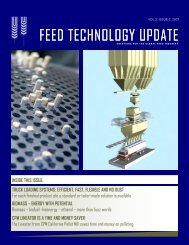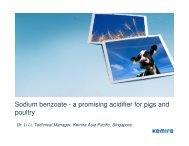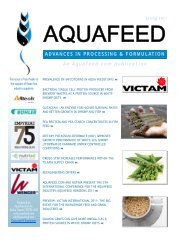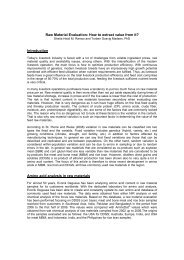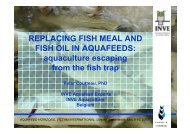FEED TECHNOLOGY UPDATE - AquaFeed.com
FEED TECHNOLOGY UPDATE - AquaFeed.com
FEED TECHNOLOGY UPDATE - AquaFeed.com
Create successful ePaper yourself
Turn your PDF publications into a flip-book with our unique Google optimized e-Paper software.
DENSITY CONTROL<br />
is also referred to as a product’s true density.<br />
EXTRUSION PROCESS CONSIDERA-<br />
TIONS<br />
Energy management can be essential to<br />
controlling bulk density of extruded feeds.<br />
As energy inputs increase during the extrusion,<br />
the bulk density gradually decreases.<br />
Energy inputs are often classified according<br />
to their source: mechanical or thermal.<br />
The most <strong>com</strong>mon form of thermal energy<br />
addition is injection of steam to either the<br />
extruder or preconditioner.<br />
The <strong>com</strong>bination of moisture and energy<br />
allows the product to expand more easily.<br />
STEAM INJECTION<br />
Moisture added in the form of steam, injected<br />
both into a preconditioner and into<br />
the extruder barrel, brings with it additional<br />
energy for cooking.<br />
This increases capacity and reduces the requirement<br />
for large drive motors.<br />
Table 4 shows the dramatic drop in specific<br />
mechanical energy<br />
(SME) as increased levels<br />
of steam are injected<br />
into the extruder<br />
barrel.<br />
Adding steam to the<br />
preconditioner also<br />
lowers the required<br />
SME as shown in<br />
Figure 5.<br />
However, since the<br />
preconditioner has<br />
much longer retention<br />
times than the extruder<br />
barrel, there is often a<br />
much greater impact of<br />
the added energy.<br />
A closer examination of<br />
Figure 5 illustrates<br />
this.<br />
In examining the four<br />
SME (kW-hr / mton)<br />
70<br />
60<br />
50<br />
40<br />
30<br />
20<br />
10<br />
4% Steam<br />
8% Steam<br />
Table 4:<br />
Effect of Extruder Steam Injection on SME<br />
Steam Injection<br />
% dry rate<br />
0 40<br />
2 37<br />
5 30<br />
7 27<br />
SME<br />
(kWh/t)<br />
percent steam injection curve one can see<br />
that as the retention time in the preconditioner<br />
is increased the extruder SME declines.<br />
Direct steam injection is one of the two primary<br />
heating methods for most extrusion<br />
cooking processes.<br />
There are several ways to adjust the SME<br />
input. These include hardware changes including<br />
the screw configuration and die configuration.<br />
For example, additional cut-flight screws or<br />
a more restrictive die can increase the energy<br />
added.<br />
Note: Same running conditions, except DDC steam flow levels<br />
0<br />
0 1 2 3 4 5 6 7<br />
Time (min)<br />
Figure 5 Effect of Conditioner Steam Injection on SME<br />
• <strong>FEED</strong> <strong>TECHNOLOGY</strong> <strong>UPDATE</strong> — June/July 2006 •


